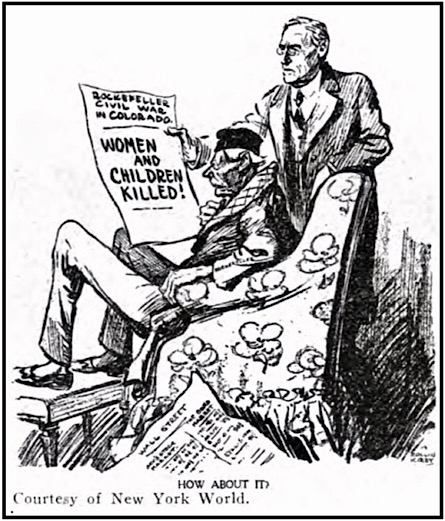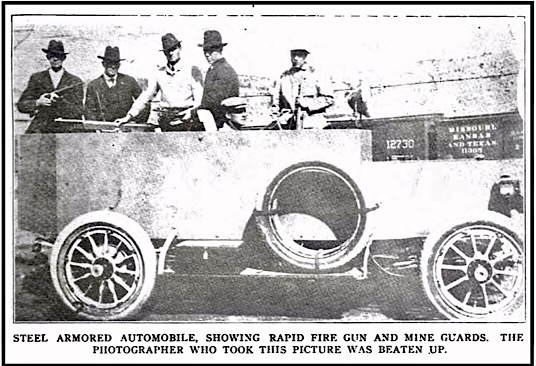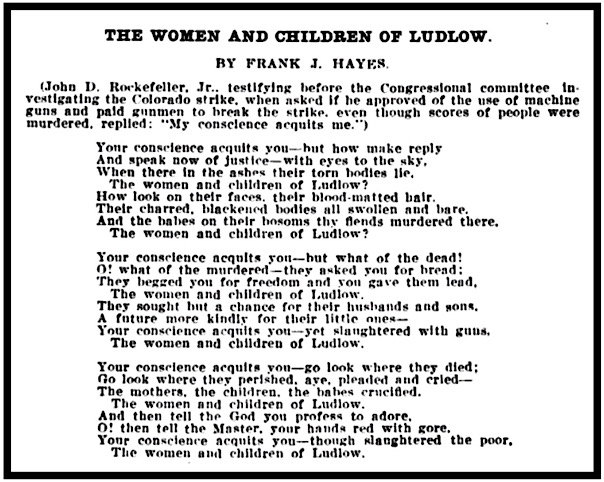 —————
—————
Hellraisers Journal – Saturday June 6, 1914
Clara Ruth Mozzor Describes Ruins of Ludlow Two Days After Massacre
From the International Socialist Review of June 1914:
The following article is written with deep feeling by Clara Ruth Mozzor who was present at the death-pit as the bodies of the women and children were recovered from the Black Hole of Ludlow:
“LUDLOW”
By Clara Ruth Mozzor
TWO days following the Ludlow massacre I came upon the ruins of the tent colony. Ludlow was still a smoldering, smoking mass of ashes. What was once the homes of these men who had come across the seas to build for their wives and babies was now an aching desolation. I came to get at the bottom of the trouble that caused a colony in which there were women and children to be fired on by machine guns and soldiers’ rifles.
Waste and ruin, death and misery were the harvest of this war that was waged on helpless people. The ruthlessness of the steady fusillade of bullets from the machine guns turned against these people by the terrific force of capital in the human form of the inhuman octopus John D. Rockefeller, wiped out whole families, separated husbands and wives, mothers and babies and sent into the beyond little ones whose day of life was but a short time off.
Only a few weeks ago Ludlow was a colony of life. Eight American flags waved gladly in the air over its tents. Here was going on the making of Americans in this great western melting pot in the southern coal fields of Colorado.
And on these self-same ruins was enacted the most awful tragedy, the darkest chapter of American history, the Ludlow massacre when sleeping families were made the targets with which to break the backs of the strikers.
The very region of Ludlow is one of nature’s hell holes, full of its dark canyons and deep arroyos, its hills and mountains. And in these mountains, in these Black Hills are scattered the men. Many of them do not know where their families are. Some of the women and children are still in the friendly ranch houses, while most of them are in the shelter of Trinidad homes and refuges thrown open to them.
The entire southern district is in the throes of war. Not civil, but industrial warfare, that has made such a reign of terror as must forever remain a black spot in the history of the state and nation. Ludlow is not the beginning of this war of desolation and sorrow. Seven months ago the union men went on strike. They demanded many things, but they were willing to waive them all should they only be given the recognition of their union.
Today in Ludlow stalks the spirit of the dead, the massacred and the slaughtered. Mothers with babies at their breasts and babies at their skirts and mothers with babies yet unborn were the targets of this modern warfare.
And why? is the question. “Why should this be so?” seems to be written across the early morning sky. The question is not now one of who fired first, but why were women and children fired upon?
In Ludlow the militia answer the question. In Trinidad and where the refugees were, the miners answer the question.
Major Hamrock, the officer who was in command of the Ludlow militia on the day of the attack on the tent colony, to all questions answers only “Self defense.”
“But the machine guns, they were used against women and babies; were they not?”
“Yes, but we thought they had fled.”
“Where to? When? They had no time, had they?”
“No, but we thought they were gone.”
“We gave them warning,” said another officer.
“We had trained machine guns on the colony before,” said still another.
No one agreed on the minor question of why? but all knew that machine guns were trained on the colony sometime early in the morning.
“Did you fire the tents?”
“No,” was the answer, “that was due to an explosion in the camp.” And that is the story of the militia. “Self defense, self defense,” insisted the commanding officer.
And then comes the other side.
“They fired the machine guns on us to better destroy the colony,” say the strikers.
“They came to us demanding that we deliver up to them a man who was never with us. They had no civil authority to search the camp and the military had already been removed.
“Then came a call for a conference with the Greek leader of the colony, Louis Tikas. He was coming back to us, waving a white flag in his hand, when two bombs went off and the firing started from the militia in front of us and the machine guns to the rear. Our men snatched their rifles and made an open dash for the hills, thinking thereby to draw the fire to themselves and leave us women and children free. But the militia was bent on exterminating us. They fired on us all day long. Some of us were in the pits and dugouts the men had made and some of us were in wells and in the pump house.
“And then at sundown,” and the women have given this out on affidavit, “at sun down, we saw the soldiers go from tent to tent, and as they left each tent would become a blazing ruin.”
“At night we fled, some to the ranch houses and some to the depot where a train took us to Trinidad.”
This is the story of the refugees. There was still another story. The story of the dead. On the afternoon that I was at Ludlow, out of one pit, the “Black Hole of Ludlow,” the bodies of eleven children and two women were taken, smothered and mangled, charred, burned and swollen. One by one they were placed on the dead wagons and taken into Trinidad. Mexican women and two babies, a third that was to give birth in three months; another woman and her three children, and still another baby that was born dead three days after the mother had been killed. This baby came after the mother was brought to Trinidad. Physicians said it was the strangest child birth ever given to woman. That same day Charles Costa, the father of the family, was brought in from the sand pits in front of the Black Hills, where he had been doing duty, shot in two.
These were the dead.
In Trinidad were also the living dead. In a cheap boarding house, up several flights of steps, following winding corridors, in a dim lit windowless room, lay Mary Pedrigon [Mary Petrucci or Alcarita Pedregone?]. She was living and yet her mind was dead. She had escaped from Ludlow, but her babies were smothered in the pit that held those other women [Maria Valdez and Cedi Costa] and children. Mary Pedrigon was thin and wasted. And over and over again her parched lips would repeat the names of her little ones, the only persons that Mary Pedrigon could remember.
In another house was a mother, three babies and a father. They were mourners. Frank Snyder, their ten-year-old boy, had been shot before their very eyes. The little one playing in the tiny room, happy and laughing, but in the ears of the mother was not the sound of the voices of the babies left to her, but of the boy, Frank, the back of whose head had been shot off by a bullet.
These are the stories, living and dead, of Ludlow. These were the incidents that marked the Ludlow massacre. These are facts as I found them and the people as I saw them.
And still in my ears rings the unanswered question, “Why?”
[Emphasis added.]
Vincent St. John: The Ludlow Massacre “has served to emphasize the fact that the workers have no rights that the employers respect.”
The Lesson of Ludlow
by Vincent St. John
THE massacre of striking miners, their wives and children, at Ludlow, Colo., by hired gunmen and state militia of the coal operators has served to emphasize the fact that the workers have no rights that the employers respect.
The use of degenerate thugs in strikes as the upholders of “Law and Order” is not confined to the state of Colorado. With few, if any, exceptions, they have been in evidence whenever the profits of the employers were attacked, or their control of industry seriously disputed. The degree of activity may have differed; they may have been clothed with the authority of a state or county at different times, but they have always been present to supply the might needed to enforce the dictates of the employing class.
The southwestern coal fields of Colorado have always been dominated by the rule of the gunman. In the past the peace ( ?) officers of that section have deported, beaten up, or murdered all organizers who attempted to interfere with the undisputed sway of the coal mine operators.
Whenever the discontent of the coal miners has crystallized sufficiently to give indication of concerted action, the authorized thugs have been supplemented by special guards, whose sole function is to eliminate any and all of the miners whose activity and experience gives any promise of success in the attempt to form an organization.
[…..]
It is well that the workers organized and unorganized have responded with funds to enable the strikers to maintain and defend themselves. Nothing else would serve the immediate needs of the men and women on the firing line. It is better still to note the spirit that has actuated workers who have declared their intention of taking an actual part in the conflict if necessary. But the problem can not be solved by meeting the hirelings of the employing class in armed conflict, however necessary such actions may be at times.
There is but one way that the workers can avenge Ludlow. There is but one way that they can prevent its repetition in some future struggle for better conditions.
That way is to so organize that never again will any body of workers have to carry on a protracted struggle against the employers, isolated from all save financial and moral support. Let the example set by the four train crews who refused to operate trains carrying soldiers and gunmen into the strike bound camps be our inspiration for the future. Let us resolve that from this time on, an injury to one is the concern of all and that the wheels of industry shall stop and profits shall cease to flow into the coffers of any of the employing class whenever any part of our class is engaged in a fight for better conditions.
If this lesson be learned, the death of the miners and their wives and children at Ludlow will not have been in vain.
[Emphasis added.]
~~~~~~~~~~~~~~~~~~~~~~~~~
SOURCES & IMAGES
Quote KE Linderfelt re Damn Red Neck Bitches of Ludlow Massacre,
Apr 20, 1914, CIR p7378
https://babel.hathitrust.org/cgi/pt?id=uiug.30112087783327&seq=398&q1=red+bitches&start=1
International Socialist Review
(Chicago, Illinois)
-June 1914, p708, p725
https://www.marxists.org/history/usa/pubs/isr/v14n12-jun-1914-ISR-gog-ocr.pdf
See also:
-re “How About It?” by Rollin Kirby
Cartoons Magazine, Volume 6
H.H. Windsor, Editor and Publisher, 1914
(search: kirby) p127
https://books.google.com/books?id=6XFIAAAAYAAJ
Clara Ruth Mozzor Neuhaus, 1892-1949
https://www.findagrave.com/memorial/260212922/clara_ruth_neuhaus
https://en.wikipedia.org/wiki/Clara_Ruth_Mozzor
Sunset, Volume 38
Passenger Department, Southern Pacific Company, 1917
(search: mozzor) p41-with photo, age 24,
junior assistant attorney general of CO
https://books.google.com/books?id=la4RAAAAYAAJ
Articles, Poems, Accounts of Ludlow Massacre
https://www.marxists.org/history/usa/workers/ludlow/index.htm
1977 Song: “Bloody Ludlow”-O. V. Hirsch, Coal Miner
https://youtu.be/-gHWN5SrZhU?si=XVkCh5XozPEOvIsb
Hellraisers Journal – Friday June 5, 1914
Artists of The Masses Portray the Ludlow Massacre; Max Eastman Describes “Class War in Colorado”
Tag: Ludlow Massacre
https://weneverforget.org/tag/ludlow-massacre/
Tag: Colorado Coalfield War of 1914
https://weneverforget.org/tag/colorado-coalfield-war-of-1914/
Tag: Colorado Coalfield Strike of 1913-1914
https://weneverforget.org/tag/colorado-coalfield-strike-of-1913-1914/
~~~~~~~~~~~~~~~~~~~~~~~~~
The Women and Children of Ludlow – Tom Breiding



